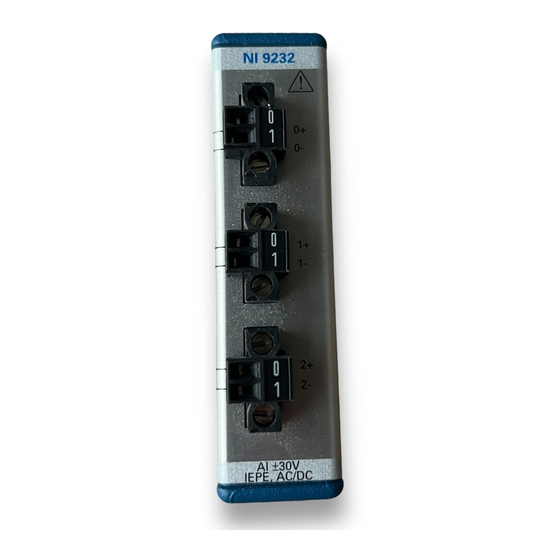Table of Contents
Advertisement
Quick Links
Advertisement
Table of Contents

Summary of Contents for National Instruments NI-9232
- Page 1 NI-9232 Getting Started 2022-07-06...
-
Page 2: Table Of Contents
Connecting the NI-9232........ -
Page 3: Before You Begin
Safety Guidelines for Hazardous Locations The NI-9232 is suitable for use in Class I, Division 2, Groups A, B, C, D, T4 hazardous locations; Class I, Zone 2, AEx nA IIC T4 Gc and Ex nA IIC T4 Gc hazardous locations;... - Page 4 II 3G and is suitable for use in Zone 2 hazardous locations, in ambient temperatures of -40 °C ≤ Ta ≤ 70 °C. If you are using the NI-9232 in Gas Group IIC hazardous locations, you must use the device in an NI chassis that has been evaluated as Ex nC IIC T4, Ex IIC T4, Ex nA IIC T4, or Ex nL IIC T4 equipment.
-
Page 5: Electromagnetic Compatibility Guidelines
Furthermore, any changes or modifications to the product not expressly approved by National Instruments could void your authority to operate it under your local regulatory rules. Notice To ensure the specified EMC performance, operate this product only with shielded cables and accessories. -
Page 6: Cable Requirements For Emc Compliance
3 m (10 ft). Cable Requirements for EMC Compliance Select and install cables for the NI-9232 in accordance with the following requirements: Connect the cable shield to the chassis ground (grounding screw of the ■... -
Page 7: Special Conditions For Marine Applications
EMC performance is attained. Preparing the Environment Ensure that the environment in which you are using the NI-9232 meets the following specifications. Operating temperature (IEC 60068-2-1, IEC 60068-2-2) -40 °C to 70 °C... -
Page 8: Connecting The Ni-9232
Note You must use 2-wire ferrules to create a secure connection when connecting more than one wire to a single terminal on the NI-9232 with screw terminal. Each channel has a terminal to which you can connect a signal source. The AI+ terminal of the connector provides the DC excitation, when enabled, and the positive input signal connection. -
Page 9: Wiring For High-Vibration Applications
NI-9232 Getting Started If you make a ground-referenced connection between the signal source and the NI-9232, make sure the voltage on the AI+ and the AI- connections are in the channel-to-earth safety voltage range to ensure proper operation of the NI-9232. -
Page 10: Ni Services
NI product. Product registration facilitates technical support and ensures that you receive important information updates from NI corporate headquarters is located at 11500 N Mopac Expwy, Austin, TX, 78759-3504, USA. ni.com © 2022 National Instruments Corporation.















Need help?
Do you have a question about the NI-9232 and is the answer not in the manual?
Questions and answers